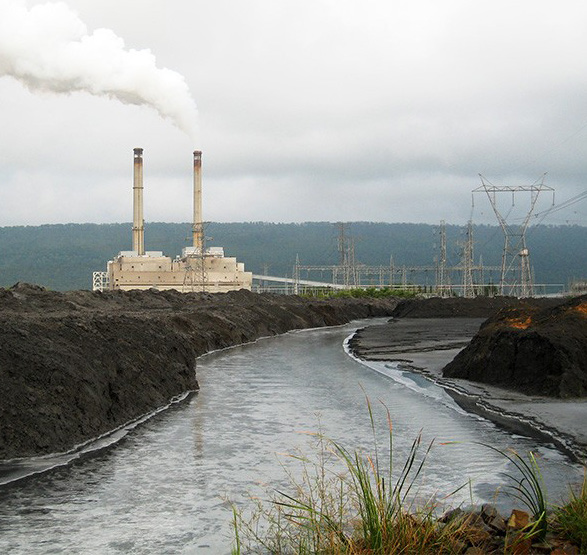EPA has proposed to strengthen water pollution standards for coal-fired power plants
EPA’s new proposal would require more stringent Clean Water Act wastewater treatment standards for coal-fired power plants, which are known as Effluent Limitation Guidelines (ELGs). ELGs are national regulations that require polluters to use the most modern and effective pollution control technologies to treat wastewater before discharging into rivers, lakes, and other water bodies. If finalized, these standards would eliminate at least 584 million pounds of toxic pollutants every year, while providing $1.4 billion in annual benefits to society.
Power Plant Pollution Threatens Public Health and the Environment
Coal-fired power plants are one of the largest direct dischargers of toxic pollutants to rivers, lakes, and other water bodies. Coal plant wastewater contains arsenic, mercury, selenium, lead, bromide, nutrients, and other harmful pollutants that can wreak havoc on water resources and aquatic life, even in small amounts. This pollution has made it unsafe to swim or fish in many water bodies across the country. Communities that depend on subsistence fishing are especially vulnerable.
EPA estimates that 42 million people rely on drinking water sources likely contaminated with coal plant wastewater. Bromide and other halogens pose particular public health risks and present challenges for drinking water systems, because bromide in treated water can result in the formation of carcinogenic disinfection byproducts (DBPs).
Strong Pollution Standards for Power Plants Are Long Overdue
Prior to 2015, the ELGs for coal plants had not been updated since 1982. The 2015 rule — which was promulgated in response to years of legal action from public health and environmental groups — prohibited dumping fly and bottom ash wastewater into the nation’s waters. It also imposed the first-ever limits on toxic pollutants including arsenic and selenium in the wastewater from air pollution control devices called “scrubbers.”
In 2020 the Trump administration weakened the 2015 pollution standards for two of the largest and most toxic coal plant wastewater streams — bottom ash wastewater and scrubber sludge. The 2020 rule also exempted certain power plants from having to upgrade their wastewater treatment technology and pushed back compliance dates for the weakened standards. The rule also ignored a 2019 court order to strengthen limits on leachate and “legacy” wastewater — two other highly toxic wastewater streams discharged from coal plants.
The new ELG rule proposed by EPA in March 2023 is in direct response to a 2020 lawsuit brought by environmental groups that challenged the weakening of the 2015 ELG rule. It also addresses the 2019 court order to strengthen pollution standards for leachate and legacy wastewater ponds.
What are Clean Water Act Effluent Limitations Guidelines and Standards (ELGs)?
- The goal of the Clean Water Act was to eliminate pollution by 1985.
- ELGs are regulatory standards for wastewater discharged to surface waters and municipal sewage treatment plants.
- ELGs are issued on an industry by-industry basis; EPA has issued ELGs for 59 different industrial sector categories to date.
- ELGs are technology based an establish a minimum floor of protection in Clean Water Act discharge permits.
- EPA must minimize pollution, and eliminate it where possible, by requiring the Best Available Technology.
Highlights of Proposed Pollution Standards
- Would require coal-fired power plants to upgrade their wastewater treatment technology to achieve zero discharge of pollutants from bottom ash transport wastewater and flue gas desulfurization (FGD) scrubber sludge, which are two of the largest toxic wastewater streams coming from these plants.
- Would require coal plants to upgrade wastewater treatment technology to meet new, stricter limits for leachate, which is wastewater that percolates through coal ash dumps.
- Does not propose a national technology-based standard for legacy wastewater stored in coal ash ponds, but rather proposes that these pollution limits be derived on a site-specific basis based on a state permit writer’s “best professional judgment.”
- Would eliminate loopholes in the 2020 ELG that exempted certain coal plants from having to upgrade their wastewater treatment technologies.
- Many plants will be able to delay complying with the new, stricter standards until December 2029.
- Coal plants that have already installed less effective treatment technologies and intend to retire by 2032 will not have to comply with the more stringent standards.
EPA Must Strengthen These Standards
The coal plant industry has been getting a free pass for over 40 years and it's long past time that these power plants treat all of their wastewater using modern and effective pollution control technologies. In addition to finalizing the zero-discharge requirement for bottom ash transport water and FGD scrubber sludge, EPA must strengthen the standards for leachate and legacy pond wastewater. EPA must also accelerate the compliance schedule to ensure that coal plants adopt the new pollution standards as quickly as possible.
Download This Page
as a Printable Factsheet
Submit A Public Comment
before May 30th, 2023

